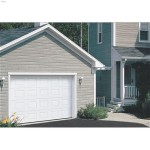Wi-Fi Garage Door Controllers: Enhancing Home Automation and Security
The integration of smart technology into residential settings has witnessed significant growth, with homeowners increasingly seeking convenience, security, and energy efficiency. Among the various smart home devices available, the Wi-Fi garage door controller stands out as a particularly useful and practical addition. This technology allows users to remotely monitor and control their garage doors via a smartphone app or web interface, offering a range of benefits that traditional garage door openers simply cannot match.
The core function of a Wi-Fi garage door controller is to bridge the gap between a conventional garage door opener and a home's Wi-Fi network. This bridge enables remote access and control, effectively transforming a standard garage door into a smart device. The controller typically consists of a small hardware module that connects to the existing garage door opener motor and a dedicated mobile application or web platform used for remote operation. Installation generally involves connecting the controller wires to the appropriate terminals on the garage door opener and then configuring the device to connect to the home's Wi-Fi network.
The benefits of using a Wi-Fi garage door controller are manifold, addressing various concerns related to security, convenience, and monitoring. These advantages extend beyond simple remote operation, offering a comprehensive solution for managing garage access and enhancing the overall smart home ecosystem.
Enhanced Security and Monitoring
One of the primary advantages of a Wi-Fi garage door controller is its contribution to enhanced security. Traditional garage door openers are often vulnerable to unauthorized access, either through compromised remote controls or forced entry. Wi-Fi controllers address these vulnerabilities by providing real-time monitoring and alerts. Users receive notifications on their smartphones whenever the garage door is opened or closed, allowing them to track activity and identify potential security breaches.
Many Wi-Fi garage door controllers also integrate with home security systems, further bolstering protection. Integration allows the garage door status to be incorporated into the overall security monitoring, triggering alerts if the door is opened unexpectedly during specific hours or when the house is unoccupied. This proactive approach to security can deter potential intruders and provide peace of mind to homeowners.
Furthermore, Wi-Fi controllers often offer features such as activity logs, which record the time and date of each garage door operation. This history provides a valuable record in the event of a security incident, allowing users to review past activity and identify any suspicious patterns. Some models even include video surveillance capabilities, enabling users to visually verify the status of their garage and identify individuals entering or exiting the premises. The combination of real-time alerts, security system integration, and activity logs provides a significantly more secure garage door solution compared to traditional openers.
Convenience and Remote Access
Beyond security, Wi-Fi garage door controllers offer unparalleled convenience. The ability to remotely control the garage door from anywhere with an internet connection eliminates the need for physical keys or remote controls. This is particularly useful in various scenarios, such as granting access to delivery personnel, letting in family members, or ensuring the garage door is closed after accidentally leaving it open.
The remote access functionality allows users to control the garage door even when they are away from home. For example, if a user receives a notification that the garage door is open while at work, they can remotely close it using their smartphone app. This feature is especially valuable for those who frequently forget to close the garage door or who want to grant temporary access to visitors without having to provide them with a physical key. Some controllers also support voice control through integration with virtual assistants like Amazon Alexa or Google Assistant, allowing users to operate the garage door with simple voice commands.
The convenience extends to scheduled operations. Some controllers support the programming of schedules, automatically opening or closing the garage door at pre-defined times. This can be useful for automating routines, such as opening the garage door in the morning before leaving for work or closing it automatically at night. The ability to customize schedules and remotely control the garage door from anywhere significantly enhances convenience and streamlines daily routines.
Integration with Smart Home Ecosystems
Wi-Fi garage door controllers seamlessly integrate with other smart home devices and platforms, creating a more cohesive and automated home environment. This integration allows users to create custom automation routines and control multiple devices from a single interface.
For instance, a user could create a routine that automatically turns on the garage lights when the garage door is opened, providing illumination and enhancing safety. Integration with smart thermostats can also improve energy efficiency, automatically adjusting the thermostat settings when the garage door is opened or closed, preventing unnecessary heating or cooling loss. Furthermore, integration with smart locks can coordinate access control, automatically unlocking the front door when the garage door is opened, allowing for seamless entry into the home.
The ability to integrate with various smart home platforms is a key advantage of Wi-Fi garage door controllers. These platforms, such as IFTTT (If This Then That), allow users to create custom applets that automate tasks based on triggers from different smart devices. For example, a user could create an applet that sends a notification if the garage door is left open for more than a certain period of time, providing an additional layer of security and alerting the user to potential issues. The flexibility and customization offered through smart home integration significantly enhance the functionality and value of Wi-Fi garage door controllers.
The installation process for a Wi-Fi garage door controller typically involves a few key steps. First, the device must be physically connected to the existing garage door opener. This usually entails connecting wires from the controller to the terminals on the garage door motor that control the door's operation. The specific wiring configuration may vary depending on the model of the garage door opener, so it is important to consult the manufacturer's instructions for both the controller and the opener.
Once the device is physically connected, the next step is to connect it to the home's Wi-Fi network. This usually involves downloading the controller's mobile app and following the on-screen instructions to configure the Wi-Fi connection. The app will typically guide the user through the process of selecting the Wi-Fi network and entering the password. After the Wi-Fi connection is established, the app can be used to control the garage door remotely.
Many Wi-Fi garage door controllers also require a calibration process to ensure proper operation. This involves training the controller to recognize the open and closed positions of the garage door. The app will typically guide the user through this process, instructing them to open and close the garage door a few times while the controller learns the travel limits. Proper calibration is essential to ensure that the controller accurately monitors the door's status and operates it reliably.
Considerations when selecting a Wi-Fi garage door controller involves several factors, including compatibility with the existing garage door opener, security features, and integration capabilities. Not all Wi-Fi controllers are compatible with every garage door opener model, so it is important to verify compatibility before making a purchase. The controller should also offer robust security features, such as encryption and multi-factor authentication, to prevent unauthorized access. Finally, the controller should integrate seamlessly with the user's existing smart home ecosystem, allowing for easy control and automation.
The ongoing maintenance of a Wi-Fi garage door controller is typically minimal. Users should periodically check the device's connection to the Wi-Fi network to ensure it is stable. It is also important to keep the controller's firmware updated to the latest version to ensure optimal performance and security. The mobile app should also be kept up-to-date to receive the latest features and bug fixes. It is also advisable to periodically check the wiring connections to ensure they are secure and free of corrosion. By performing these simple maintenance tasks, users can ensure that their Wi-Fi garage door controller operates reliably for years to come.

Nexx Smart Wi Fi Garage Door Controller Nxg 100b Black

Genie 39142r Aladdin Connect Smartphone System

Wifi Garage Door Switch Opener Smart Gate Controller Life Control Smarten Your

Smart Wi Fi Garage Door Opener Remote App Control Google Assistant Alexa

886lmw Wifi Motion Detecting Control Panel Accessories Liftmaster

Chamberlain B4613t Belt Drive Smart Garage Door Opener 3 4 Hp

Wifi Smart Garage Door Openers Liftmaster

B4505t Ultra Quiet Wi Fi Garage Door Opener Chamberlain

Nexx Smart Wi Fi Garage Door Controller Nxg 300

Tellur Wifi Garage Door Control Switch Compatible With Alexa Google Home








